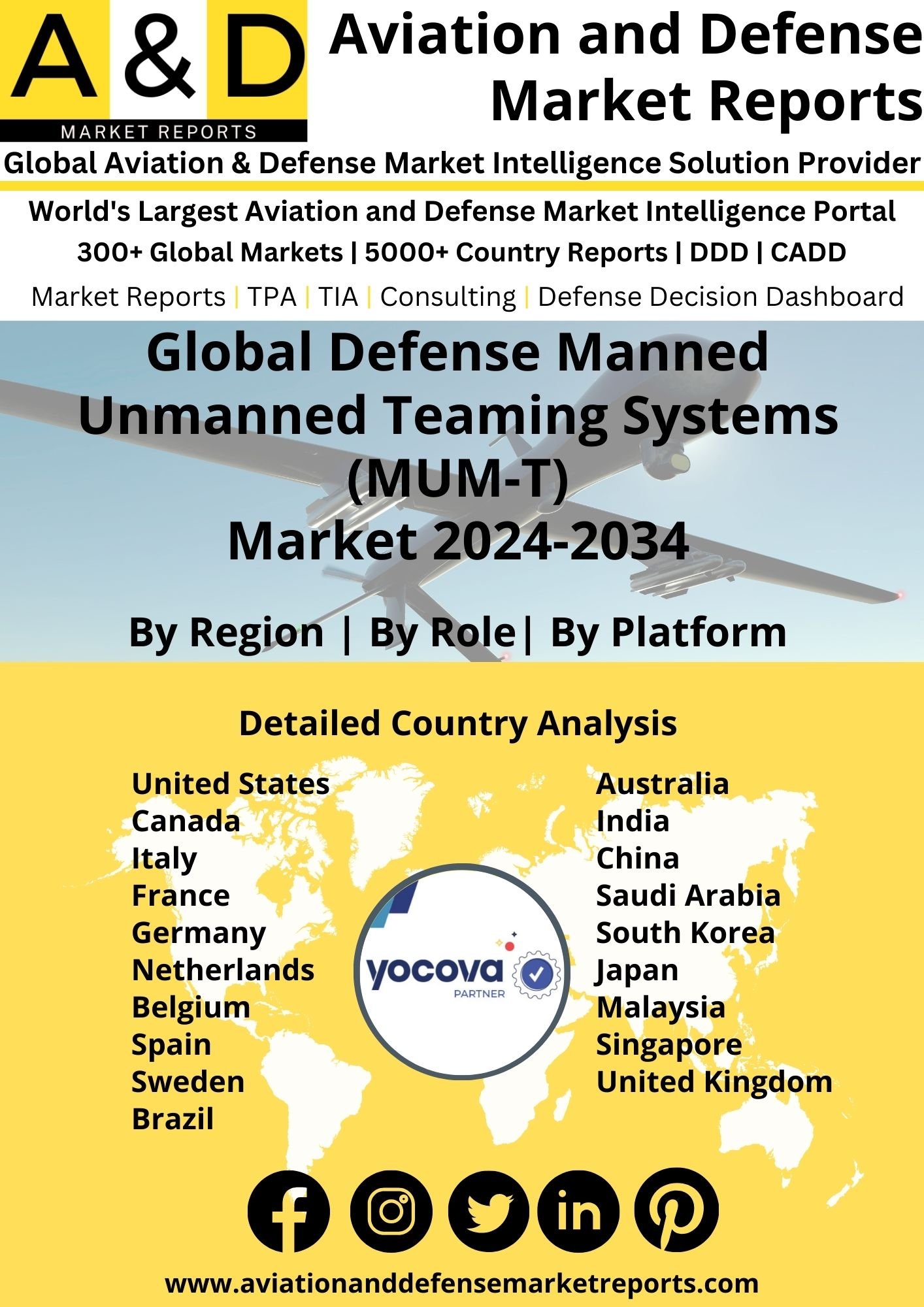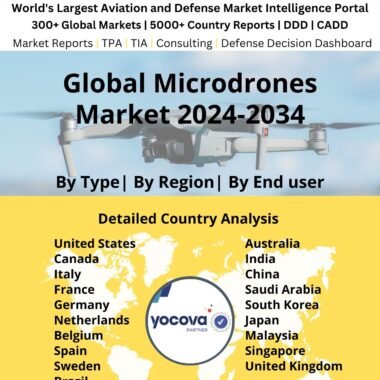Description
Defense Manned Unmanned Teaming Systems (MUM-T) Market
The transition from manned to unmanned assisted combat systems represents a significant evolution in military technology and tactics. This transition involves the integration of unmanned platforms, such as drones and autonomous vehicles, into traditional combat operations alongside manned forces. Here’s an overview of this concept: Manned combat systems involve soldiers or human operators directly engaging in combat actions. These could be infantry soldiers, pilots, tank crews, etc. While they bring human decision-making, adaptability, and judgment to the battlefield, they also face limitations in terms of endurance, reaction time, and vulnerability to physical and psychological stress.
Unmanned systems, on the other hand, are vehicles or devices operated remotely or autonomously, without human presence onboard. These systems have seen rapid advancement in recent years due to advancements in robotics, artificial intelligence, and communication technologies. Drones, ground robots, and autonomous vehicles fall under this category. They offer advantages like reduced risk to human personnel, longer endurance, and the ability to operate in hazardous environments.
Unmanned Assisted Combat Systems:
The concept of unmanned-assisted combat systems involves integrating unmanned platforms into traditional combat scenarios to enhance the effectiveness and survivability of human forces. This can manifest in several ways:
Surveillance and Reconnaissance: Drones can provide real-time situational awareness by collecting intelligence and relaying information back to human operators, assisting them in making informed decisions.
Targeting and Engagement: Drones can assist manned platforms in identifying and engaging targets, reducing the risk to human personnel while improving precision and accuracy.
Logistics and Support: Unmanned vehicles can be used for transporting supplies, medical aid, and equipment, reducing the strain on human logistical efforts.
Electronic Warfare: Autonomous systems can conduct electronic warfare operations, such as jamming enemy communication systems or intercepting signals.
Remote Sensing: Unmanned sensors and reconnaissance systems can be deployed in hazardous environments or areas that are hard to access for humans.
Swarm Tactics: Groups of unmanned vehicles can operate together as a swarm, leveraging coordinated tactics to overwhelm and confuse adversaries.
Manned-unmanned teaming (MUM-T) refers to the coordinated operations between manned and unmanned platforms across various defense domains, such as air, ground, naval, and even space. This concept leverages the strengths of both human operators and autonomous systems to enhance overall operational capabilities. In the aviation domain, MUM-T involves the collaboration between manned aircraft and unmanned aerial vehicles (UAVs) or drones. Manned aircraft can deploy drones for extended surveillance and reconnaissance, providing real-time data to the pilots and ground operators. Drones can be employed to disrupt enemy communication systems, allowing manned aircraft to operate in a more advantageous environment.
In ground operations, MUM-T involves cooperation between human soldiers and autonomous or remotely operated ground vehicles. Unmanned ground vehicles (UGVs) can scout ahead, sending data back to human soldiers and providing valuable situational awareness. UGVs can transport supplies and equipment, relieving soldiers of the burden and reducing their vulnerability. In naval contexts, MUM-T can involve coordination between human-operated naval vessels and autonomous underwater vehicles (AUVs) or drones. AUVs can conduct underwater surveys, collect data, and provide submarines. Autonomous underwater vehicles can identify and neutralize underwater mines, protecting manned naval vessels. detection capabilities. Drones and AUVs can be employed in collaborative efforts to locate and track enemy submarines.
Major factors driving Defense Manned Unmanned Teaming Systems (MUM-T) Market Growth
Manned-unmanned teaming (MUM-T) is driven by a combination of technological, operational, and strategic factors that contribute to its adoption and advancement across various defense sectors. MUM-T helps mitigate risks to human personnel in dangerous or high-threat environments, thereby reducing casualties and enhancing overall force protection. Unmanned systems can be more cost-effective than maintaining fully manned platforms, as they can perform certain tasks without the need for on-board crew facilities and support systems. Modern military operations often involve dealing with complex and evolving threats, including asymmetric warfare, terrorism, and cyber warfare. MUM-T allows for a more adaptable and versatile response to these threats. Unmanned systems can act as force multipliers, extending the capabilities of existing manned platforms and enabling them to cover larger areas or execute multiple tasks simultaneously.
As military strategies evolve, there is a growing recognition of the value of integrating unmanned systems into traditional operations. This integration aligns with the concept of network-centric warfare and the use of information and communication technologies to achieve strategic goals.
Trends Influencing the Defense Manned Unmanned Teaming Systems (MUM-T) Market Size
Advancements in robotics, artificial intelligence (AI), sensor technologies, communication systems, and automation have paved the way for more sophisticated and capable unmanned systems. These technologies enable unmanned platforms to operate more autonomously and effectively collaborate with manned platforms.
Manned To Defense Manned Unmanned Teaming Systems Market (MUM-T) Forecast & Dynamics
Many countries have been investing in military modernization, which includes the integration of unmanned systems to enhance operational capabilities and maintain a technological edge. The increasing focus on urban warfare and operating in complex and congested environments has led to a demand for unmanned systems that can assist in navigation, reconnaissance, and situational awareness.
Manned To Defense Manned Unmanned Teaming Systems Market (MUM-T) Analysis for Recent Developments
IAI/ELTA Systems Ltd.’s Rex MK II Unmanned Infantry Combat Support System was used by BAE Systems to test manned-unmanned teaming (MUM-T) on the amphibious combat vehicle (ACV) C4UAS. Through improved situational awareness and decision-making skills, the teaming technology improves mission performance. The ACV C4UAS’s built-in growth capacity’s adaptability is demonstrated by the successful demonstration of MUM-T capabilities. The tactical area and mission parameters can be expanded thanks to the inclusion of MUM-T in mission planning, which also lowers the risk to people and technological assets in dangerous or hostile circumstances.
The Market is positioned at the forefront of military technological evolution, showcasing a transformative synergy between human-operated platforms and unmanned systems. MUM-T systems integrate manned and unmanned vehicles, such as helicopters and drones, to enhance operational capabilities, versatility, and situational awareness on the battlefield. This innovative approach empowers military forces to perform a wide range of missions more effectively, ranging from reconnaissance and surveillance to precision strikes and logistics. The market is witnessing a surge in demand for MUM-T systems as armed forces globally recognize the strategic advantage of combining human decision-making with the efficiency and precision of unmanned technologies. The integration of advanced communication systems, artificial intelligence, and sensor technologies allows for seamless coordination between manned and unmanned platforms, fostering a more interconnected and adaptive military force.
Collaborations between defense contractors, technology developers, and military agencies are driving advancements in MUM-T capabilities. As nations prioritize the development of autonomous and remotely piloted systems, the Global Defense Manned Unmanned Teaming Systems Market in 2023 reflects a commitment to revolutionizing military operations through the effective fusion of human expertise and cutting-edge unmanned technologies, creating a more resilient and responsive defense capability on the modern battlefield.





